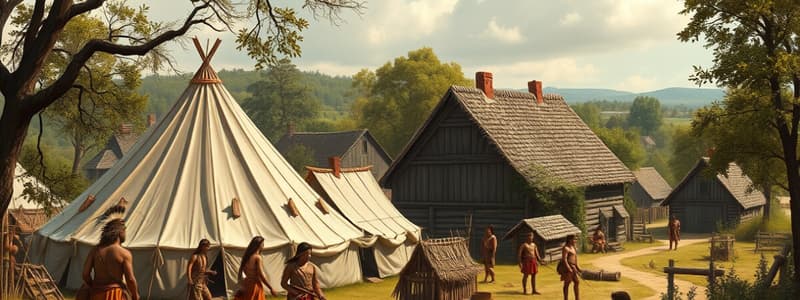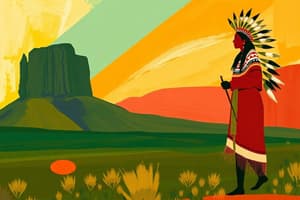Podcast
Questions and Answers
What was a significant impact of European arrival on Native Americans?
What was a significant impact of European arrival on Native Americans?
- Devastation of their populations (correct)
- Establishment of trade routes
- Cultural exchange with Europeans
- Formation of new alliances
Which of the following is not one of the three cultural hearths of the 13 Colonies?
Which of the following is not one of the three cultural hearths of the 13 Colonies?
- Midland/Middle Colonies
- New England Colonies
- Southern Colonies
- Western Colonies (correct)
In terms of political structure, how do the United States and Canada differ?
In terms of political structure, how do the United States and Canada differ?
- Canada has a President.
- Canada has a Parliament. (correct)
- The United States is a constitutional monarchy.
- The United States has fewer political parties.
What type of economy are the U.S. and Mexico increasingly developing?
What type of economy are the U.S. and Mexico increasingly developing?
Which area is predominantly associated with tobacco and cotton plantations?
Which area is predominantly associated with tobacco and cotton plantations?
Which group has been historically concentrated in the Southeast due to slavery and Jim Crow laws?
Which group has been historically concentrated in the Southeast due to slavery and Jim Crow laws?
Which statement is correct regarding the linguistic situation in the United States?
Which statement is correct regarding the linguistic situation in the United States?
What characterizes the borderland between the U.S. and Mexico?
What characterizes the borderland between the U.S. and Mexico?
What is the primary economic activity associated with the primary stage of urbanization?
What is the primary economic activity associated with the primary stage of urbanization?
Which cities are identified as key industrial cities in the American Manufacturing Belt?
Which cities are identified as key industrial cities in the American Manufacturing Belt?
Deindustrialization leads to a loss of which type of jobs?
Deindustrialization leads to a loss of which type of jobs?
How did the introduction of mass automobiles impact urbanization?
How did the introduction of mass automobiles impact urbanization?
Which of the following best describes the tertiary stage of urbanization?
Which of the following best describes the tertiary stage of urbanization?
What is a consequence of suburbanization on the downtown areas of cities?
What is a consequence of suburbanization on the downtown areas of cities?
What significant socio-economic effect was deepened by the Great Recession of 2008-2013?
What significant socio-economic effect was deepened by the Great Recession of 2008-2013?
What defines the neighborhood effect in the context of urbanization?
What defines the neighborhood effect in the context of urbanization?
Which of the following regions in North America is classified as a high-relief region?
Which of the following regions in North America is classified as a high-relief region?
What are the two major drainage systems located between the Rockies and the Appalachians?
What are the two major drainage systems located between the Rockies and the Appalachians?
Which physical feature is identified as an area of fertile farmland and is culturally important in North America?
Which physical feature is identified as an area of fertile farmland and is culturally important in North America?
Which statement accurately describes the Sierra-Nevada Mountains?
Which statement accurately describes the Sierra-Nevada Mountains?
What is the primary factor influencing climate variations at different latitudes?
What is the primary factor influencing climate variations at different latitudes?
In Köppen’s climatic classification, which letter represents temperate climate regions?
In Köppen’s climatic classification, which letter represents temperate climate regions?
Which mountain range is described as extending from Central Mexico to Central Alaska?
Which mountain range is described as extending from Central Mexico to Central Alaska?
How does ocean current affect climate according to the information provided?
How does ocean current affect climate according to the information provided?
Which region of Middle America includes seven republics?
Which region of Middle America includes seven republics?
What is a significant feature of Mexico's geography?
What is a significant feature of Mexico's geography?
What connects North America and South America in Middle America?
What connects North America and South America in Middle America?
Which of the following best describes the Lesser Antilles?
Which of the following best describes the Lesser Antilles?
Which mountain range is NOT considered part of Mexico's mountain backbone?
Which mountain range is NOT considered part of Mexico's mountain backbone?
What natural hazards are common in the Greater and Lesser Antilles?
What natural hazards are common in the Greater and Lesser Antilles?
Which phenomenon contributed to the diffusion of animals and humans across the planet?
Which phenomenon contributed to the diffusion of animals and humans across the planet?
What tectonic activity formed the approximately 7000 Caribbean islands?
What tectonic activity formed the approximately 7000 Caribbean islands?
What is the primary difference between the Greater Antilles and the Lesser Antilles?
What is the primary difference between the Greater Antilles and the Lesser Antilles?
What role do maquiladoras play in the economy around the U.S.-Mexico border?
What role do maquiladoras play in the economy around the U.S.-Mexico border?
Which factor has significantly contributed to the deforestation of tropical rainforests?
Which factor has significantly contributed to the deforestation of tropical rainforests?
How did the cultures in the Caribbean Islands change historically?
How did the cultures in the Caribbean Islands change historically?
What defines a hacienda in the context of mainland economics?
What defines a hacienda in the context of mainland economics?
Which of the following statements is true regarding the physical geography of North America?
Which of the following statements is true regarding the physical geography of North America?
What has pressured Mexico in terms of its economic competitiveness?
What has pressured Mexico in terms of its economic competitiveness?
What characterizes the plantation system in the Caribbean Coast and Islands?
What characterizes the plantation system in the Caribbean Coast and Islands?
Flashcards are hidden until you start studying
Study Notes
Indigenous North Americans
- Native Americans are the original inhabitants, known as First Nations, heavily impacted by European colonization and expansion.
- Native religions among First Nations reveal a rich spiritual heritage before European influence.
European Colonies
- Development of modern population geography stems from British and French colonial legacies.
- The 13 colonies were classified into three cultural hearths:
- New England (Plymouth Colony, focused on trade and fishing)
- Middle (Philadelphia area, agricultural focus)
- Southern (Virginia and South, known for tobacco and cotton plantations).
U.S.-Mexico Borderland
- Southwestern U.S. originally part of Mexico, leading to a population with significant Mexican heritage.
- Borderland represents a cultural transition zone with increased economic interdependence between the U.S. and Mexico.
Political Structures
- The United States functions as a republic with a President and Congress.
- Canada operates as a constitutional monarchy with a Prime Minister and Parliament.
- Both countries have multi-party political systems; Canada requires parties to pay for voting.
Regionalism and Ethnicity in the U.S.
- Indigenous populations faced significant decline in territory and political power due to westward expansion by European settlers.
- African Americans remain concentrated in the Southeast due to historical factors like slavery and Jim Crow laws.
- Hispanic populations are increasingly dispersing throughout the U.S.
- Asian immigrants tend to cluster, predominantly along the West Coast.
Cultural Foundations
- English serves as the lingua franca, facilitating communication across the U.S.
- Christianity remains the dominant religion, showcasing regional diversity and religious tolerance.
Urbanization
- Urbanization indicates a rising population residing in urban areas, triggered by lifestyle and economic shifts.
- Rural-urban migration influences the economic landscape, particularly across major industrial cities like New York and Chicago.
Urbanization Stages
- Primary stage involves basic extraction of natural resources.
- Secondary stage includes manufacturing processes, transforming raw materials into finished goods.
- Tertiary stage represents a shift toward service-oriented economies.
Deindustrialization and Suburbanization
- Mass automotive production and highway systems contributed to the rise of suburbs, reducing reliance on central business districts.
- Deindustrialization has led to job losses in manufacturing, prompting shifts in urban landscapes.
Physiographic Regions of North America
- North America features diverse physiographic regions with significant natural landscape differences:
- High-relief areas: Pacific Mountains, Rocky Mountains, Appalachian Mountains.
- Lowland regions: Great Plains, Interior Lowlands, Coastal Plains.
Great Lakes and Great Rivers
- Two significant drainage systems: Great Lakes and St. Lawrence River in the north; Mississippi-Missouri River system towards the south.
- The Mississippi River is the fourth-longest and tenth-largest river system globally, crucial for agriculture and culture.
Geography of Climate
- Weather is the short-term state of the atmosphere; climate is long-term average weather.
- Köppen’s climate classes include tropical, dry, temperate, cold, polar, and highland regions.
- Key climate influences comprise latitude, altitude, ocean currents, and continentality.
Geography of Language
- Language diversity in North America features 15 main families, with Indo-European being the most widespread.
Regions of Middle America
- Comprised of Mexico, Central America, Greater Antilles, and Lesser Antilles; each with distinct geographical and cultural characteristics.
Mexico's Physiography
- Mexico features two peninsulas and an isthmus, characterized by significant mountain ranges, including Sierra Madre Occidental and Oriental.
Deforestation
- Historically, tropical rainforests covered two-thirds of pre-colonial areas, now reduced to only 10% due to industrial demand and population growth.
Cultural Collisions and European Competition
- European colonial interests led to the cultural and economic complexity of the region, with plantation economies reliant on enslaved labor.
- The Central American Republics like Guatemala showcase historical cultural influences and economic disparities between indigenous populations and dominant mestizo groups.
Studying That Suits You
Use AI to generate personalized quizzes and flashcards to suit your learning preferences.




